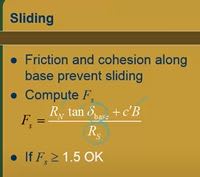Francisco A.
Geotechnical
Good morning Engineers:
As you know, Table 1, page 63 of NAVFAC 7.2 presents friction factors and adhesion values for different interface materials. If you have a shallow foundation sitting on pure cohesive soil (in this case lean clay with fines >85%) do you provide a friction factor (say 0.30) or an adhesion value (say 500 psf)for the structural engineer to size the mat against sliding?
I am clear that if the soil is purely frictional (e.g. clean sand) a friction value is the correct recommendation, but in the case of a pure cohesive soil I am not sure, as the table provide friction values for clays. I guess that if you want to provide a friction factor for a clay soil you need to estimate the effective friction angle (phi prime) of the clay in terms of its plasticity.
Furthermore, the values in this table are called ULTIMATE. Do you reduce them applying a factor or safety, or do you inform the structural engineer that the values provided are ultimate and he needs to use appropriate factor of safety. What would be that appropriate factor of safety. Thanks for you time and input!
As you know, Table 1, page 63 of NAVFAC 7.2 presents friction factors and adhesion values for different interface materials. If you have a shallow foundation sitting on pure cohesive soil (in this case lean clay with fines >85%) do you provide a friction factor (say 0.30) or an adhesion value (say 500 psf)for the structural engineer to size the mat against sliding?
I am clear that if the soil is purely frictional (e.g. clean sand) a friction value is the correct recommendation, but in the case of a pure cohesive soil I am not sure, as the table provide friction values for clays. I guess that if you want to provide a friction factor for a clay soil you need to estimate the effective friction angle (phi prime) of the clay in terms of its plasticity.
Furthermore, the values in this table are called ULTIMATE. Do you reduce them applying a factor or safety, or do you inform the structural engineer that the values provided are ultimate and he needs to use appropriate factor of safety. What would be that appropriate factor of safety. Thanks for you time and input!

